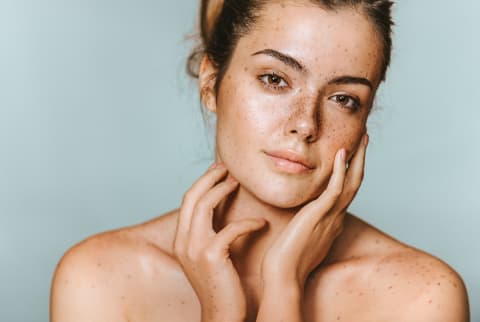Curious How To Use Ceramides For Glowing Skin? This Functional Medicine Doc Can Help


Ask a skin-care-obsessive what they yearn for every time they pat on a face oil or massage in a serum, and chances are glowing skin will be at the top of their wish list. Waking up to radiant, refreshed skin even before applying makeup is nothing short of a dream, inspiring the most adventurous of beauty gurus to slather on obscure ingredients (snail slime, blue-green algae, cork extracts, the list goes on), all in the hopes of attaining that coveted, youthful glow.
But sometimes, the most tried-and-true ingredients are your best bet, like ceramides. This active has long been hailed by dermatologists for its soothing, hydrating, and healing powers.
First, what are ceramides?
Ceramides are part of our skin's natural structure1. They are the major lipid constituent of the stratum corneum and thought to provide the barrier property of the epidermis. (Translation: They put the "barrier" in "skin barrier function.")
"They are special lipids in the outer layer of the skin, used to protect the skin and keep moisture in," says Robert Rountree, M.D., on the mindbodygreen podcast. This is exactly why, Rountree explains, these ceramides (also known as ceramosides or phytoceramides, depending on the setting) are routinely prescribed in doctors' offices or formulated in derm-favorite skin care products: "Ceramides have been used topically for a long time."
But even if you don't suffer from eczema or psoriasis, ceramides still matter: We lose them as we age, which contributes to dryness, fine lines, and wrinkles as we get older. Or if you have a compromised skin barrier, due to over exfoliation or harsh products, you might be in need of ceramides as well. That is why ceramides are crucial for keeping your skin supple and youthful. And, according to Rountree, there are a couple of ways you can use them to ensure you're getting an adequate amount.
How can you incorporate them into your routine?
The most well-known is topicals: You most often see them formulated into serums, lotions, and creams. Yet there's another way you can reap the benefits of ceramides, that offers a perfect solution for the beauty junkie who already has an extensive skin care routine. The secret, Rountree says, is to take them in supplement form.
"We get ceramides in our food. Cereal grains, like wheat, have ceramides in them," Rountree explains. However, you might be interested in speeding up the process. Science shows that ingesting them orally2 can offer those same skin-healing benefits as a prescription topical: "Research shows that when you take these things by mouth—and you don't need many milligrams of them—your body actually incorporates them into the skin," says Rountree.
Think of it as the ceramides locking in moisture from the inside out, at the cellular level—a science we at mbg are certainly behind.
So how should you really use ceramides?
The short answer—it depends. If you suffer from a super-dry condition like eczema or psoriasis, you could get a prescription from your doctor and apply the formula topically. As always, it's best to consult your dermatologist before starting any treatments, especially if you suffer from a chronic skin condition. If you have run-of-the-mill dry skin, an OTC ceramide product might do the trick.
And if you just want to optimize radiant skin no matter your age, ingest ceramides orally and let the nutrient do its work from the inside out. Take it from Rountree, who states, "We can take ceramides by mouth and get that same effect."
So whether it's upping your intake of cereal grains (rice and eggs have ceramides, too!) or supplementing with the nutrient itself, youthful, hydrated skin is in your future. Is this what it means to truly glow from within?

Jamie Schneider is the Beauty Editor at mindbodygreen. She has a B.A. in Organizational Studies and English from the University of Michigan, and her work has appeared in Coveteur, The Chill Times, and more. In her role at mbg, she reports on everything from the top beauty industry trends, to the gut-skin connection and the microbiome, to the latest expert makeup hacks. She currently lives in Brooklyn, New York.